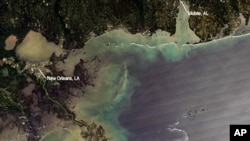When the Transocean, Ltd. oil drilling rig exploded and sank off the coast of Louisiana last week, it set off a chain of events that could have long-term economic and environmental effects on several southern U.S. states. It also could affect President Barack Obama's plans to increase off-shore drilling in the Gulf of Mexico.
The Deepwater Horizon drilling platform sat about 70 kilometers off the coast of Louisiana in the Gulf of Mexico. Last week, for reasons that still are yet to been determined - the rig exploded and sank. Most workers escaped the rig, but 11 are missing and presumed dead.
Oil from the rig has been leaking ever since and covers some 4,800 square kilometers of the Gulf of Mexico.
The sunken platform's owner, Geneva-based oil services company Transocean, Ltd., and its operator, London-based BP, have been trying to contain the spill so that it will not damage fisheries and beaches along the Gulf Coast.
Ron Rybarczyk is a spokesman for the Joint Information Center in Louisiana. He says cleanup crews are using remote controlled robots to try to activate a device called a blowout preventer some 1,500 meters below the surface. But so far, they do not know whether it is working.
"The remote operating vehicle is trying to activate fully that blowout preventer," he said. "We don't know if it is partially activated and engaged or not activated and engaged at all. But we are trying to get it fully engaged to prevent any more oil from coming out of that well head," said Rybarczyk.
The blowout preventer is a complex valve that looks like two fire hydrants stacked on top of one another. It can open and close well and it is considered critical to the safety of a rig and its crew. But oil continues to pour into the Gulf of Mexico.
Crews also are applying chemicals to the oil slick to help it evaporate and disperse more quickly. But harsh weather has hampered efforts by skimmers and other vessels from reaching the site.
Doug Helton is with the U.S. National Oceanic and Atmospheric Administration, or NOAA.
"Early on the weekend [of April 24-25], we had pretty severe weather with thunderstorms in the coastal waters and other severe weather that made it [difficult," said Helton] "We had to pull the response vessels off the water because it was too rough and too dangerous," he said.
The oil that is leaking is light sweet crude. It is almost like diesel fuel as opposed to thick, heavy crude.
Ron Rybarczyk says that most of the oil on the surface tends to be a very thin layer.
"If you can imagine putting a little bit of oil in a cup of water or a bathtub or when we see rainbow type sheen in a parking lot after a rain - it doesn't take much oil to cause a sheen that spreads a long way. So the fact that 97 percent of the surface area of this plume is sheen is a very positive thing," said Rybarczyk.
An oil spill in the Gulf of Mexico could have a devastating impact on the shrimping and fishing industries in Louisiana and neighboring states.
John Sackton is editor and publisher of seafood.com, an industry news Web site. He says that if the oil reaches Louisiana's shrimp beds, it could have far-reaching economic consequences.
"The short-term effect is that it is not possible to fish for shrimp in waters that are polluted by oil," he said. "The oil gets into the product and also it fouls the nets. So any place where there is visible oil, they would have to shut down fishing. The second problem is a longer-term problem as to whether there is anything that is toxic in the water that is going to impact shrimp survival," said Sackton.
Doug Helton of NOAA says weather could drive the oil to fragile shrimp beds, but that it could also lessen its impact.
"Oil will move and spread with winds. So we are carefully tracking the winds and forecasting the winds so we can understand how that oil is going to move and spread," he said. "The weather also has the effect of helping to disburse and break up the oil. So strong winds and choppy seas are hard for cleanup operations, but they also help to disburse and break up the oil," Helton said.
One factor working to contain the spill is that the tube that stretched from the Deepwater Horizon to the ocean floor collapsed when the rig sank. The bends and kinks in the tube are slowing the flow of oil and giving cleanup crews more time to work.
BP has proposed lowering a large dome to capture the oil and then pumping it to the surface. There are also plans to drill a relief well nearby to reduce the pressure. But both plans could take several weeks to implement.
Louisiana recently opened some of its Gulf waters to shrimp fishing. Most of the shrimp season is later in the year. But with the industry earning more than $117 million in Louisiana alone last year, stopping the flow of oil before it reaches the coastline is critical.









